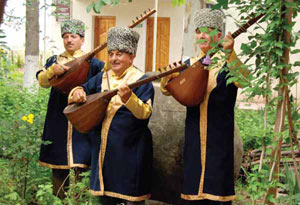Home page
» MUSIC
» Ashuq music
» About ashuq music
About ashuq music Ozan-ashug art form began to form in Azerbaijan since ancient times. Ashiq art includes songs praising of ancient epic legends, people, freedom, heroism, friendship, love songs. Ashiq art is synthetic, that is, ashig (minstrel) composes music, writes poetry, plays saz and dances simultaneously. And wind instruments ensemble and balaban often accompany ashiq. However, the main instrument of ashig is saz. Saz is ancient stringed musical instrument. The most common genre of ashiq art is the epic genre, that is epics, especially the heroic eposes. Vocal and instrumental parts in epics replace poems with parts of speech. In lyrical genre of ashiq art praising ( tariflama), beatification (“gozallama) are specially famous. This gozallama can be devoted both to the lovely, beautiful woman and the hero, for example, brave Koroglu, its legendary Qırat. Part of the ashiq songs is full of sadness, (Yaniq Karami, Dilqami), and the other part can be like in Afsharı Sharili songs, which are wonderful examples of ashug lyrics. In ashiq art ustadname genre is also interesting like advising songs. The most widely used poem rhyme in the ashuq creation is syllable. Structure of major ashuq songs is four (verse) form. Each and every couplet of verse has the beginning and each couplet is separated from each other with the instrumental solo. In ancient times and Middle Ages ashuqs called as “ozan- minstrel, varsaq, dada. The most ancient written sources on predecessors of modern Azerbaijani ashig – ozan, their ancient life, love, patriotism, the bravery is folk epos of the seventh century, Dede Korkut . Although ashuq art like set of arts combine few arts in self but the main place in this set is of traditional havajat (songs’ set). The traditional ashuq songs’ set rich with means of musical description and artistic summarizing is characterized by aesthetic constant value, polished language-style, deep philosophical means, and ethical orientation. Expressiveness of oral folk poetry (fingers count syllable rhyme) and writing poetry (aruz) comprises the base of poetry of ashug havajat. Like a part of havajat the classic ashiq poem carries out the task qaydaqoyuchuluq (normative). The mutual link of poetic text in ashiq melodies has an important influence on the formation of their melodic-rhythmic form features. The main rhyme of ashiq poetry is syllable rhyme. Structure of melodies is formed in connection with form and syllable structure of the poem, separation characteristics. Gurbani (16th century), Abbas Tufarqanlı, Sary Ashiq (17th century), Khasta Qasim, Ashiq Valeh, Ashiq Dilgam (18th century), Ashiq Ali, Ashiq Alasgar, Ashiq Hussain Shamkirli (19th century) and etc are considered as classics of ashiq art. Among ashiq of modern time Ashiq Hussein Bozalqanly, Ashiq Asad, Ashiq Mirza, Ashiq Islam, Ashiq Shamshir, Hussein Sarajly, Emrah Gulmammadov, Huseyn Javan, Ashiq Kamandar, Imran Hasanov, Mikail Azaflı, Akbar Jafarov and etc distinguish. Ashiq art is especially spread in Gazakh, Tovuz, Shamakhy regions, as well in settlements of historical Goycha and Borchali.
|
